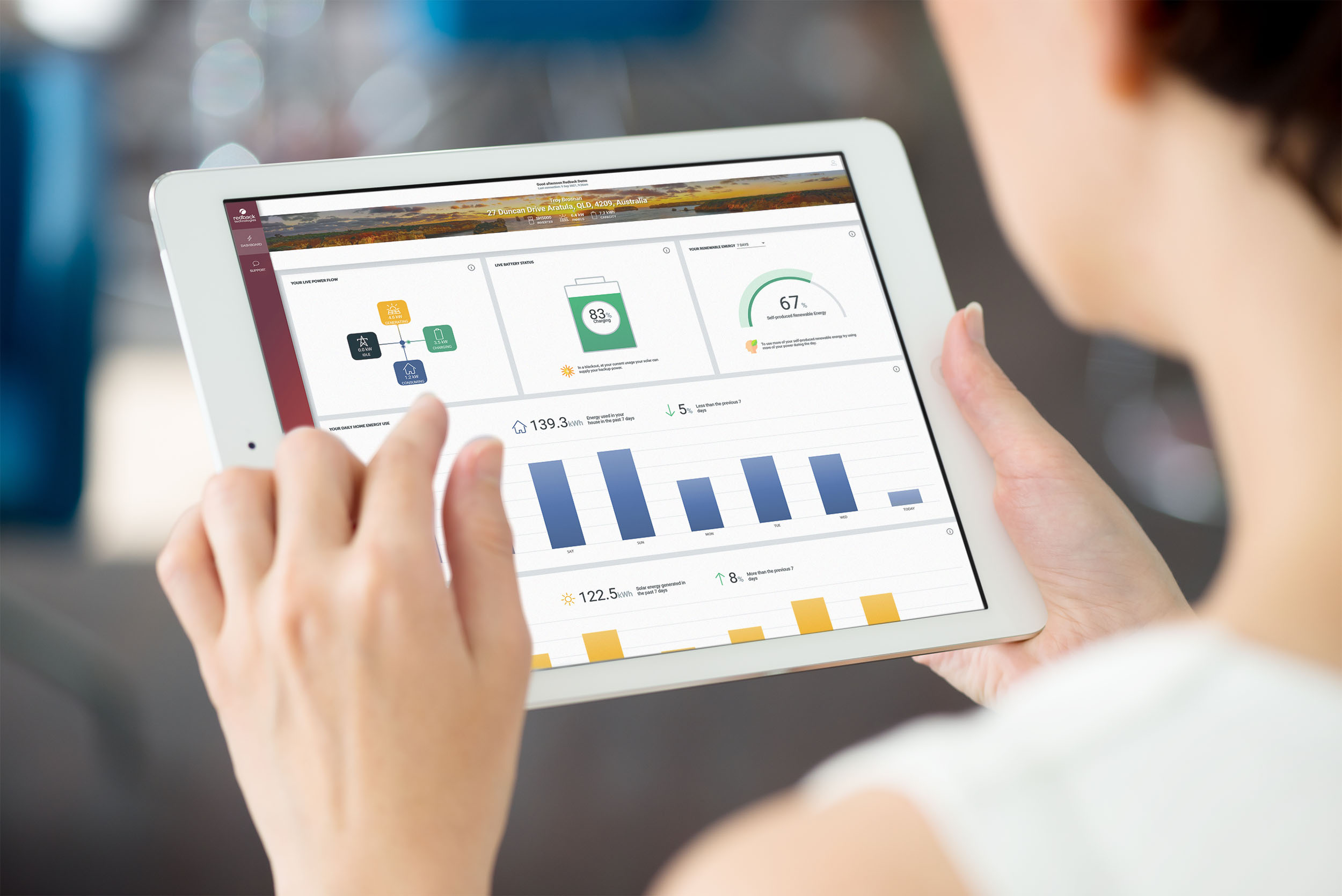Congratulations on purchasing a Redback Smart Inverter and taking the next big step in your renewable journey! This article is tailored for Redback owners like you who have recently added a solar inverter to their property or business. Here, you’ll find specialised tips designed to help you maximise the benefits of your new Redback system, so be sure to add this article to your browser’s favourites.
If you need more guidance on optimising your new system after reading this information, please contact your installer (you received their contact details in your first email from us). Or you can raise a support ticket.

How your system is working day-to-day
During daylight hours, your solar panels generate electricity from sunlight. This power flows through a solar inverter, converting it into usable electricity for your home. Any unused surplus energy is then sent to the grid, earning you a small financial credit known as a feed-in tariff, which usually appears as a credit on your electricity bill. At night or when sunlight is insufficient, your home draws power from the grid, which adds to your electricity bill.
To monitor and manage your solar system, you can use the MyRedback app or the Redback Portal. These tools allow you to track solar production, energy usage, and grid power consumption. Armed with this data, you can adjust your energy habits to potentially reduce your bills.
Small changes that can help you save
Exploring optimisation techniques can also help maximise the benefits of your solar investment while keeping your electricity bills low. So, in this section, we’ll share some valuable insights to help you maximise your solar savings and make the most of your investment.
Upgrade your hot water system
A heat pump is a device that can really help you with the costs of running your hot water system. The pump will take heat from the air and transfer it into the water – something really handy to consider if you live in a ‘hot’ region. You could also look into solar thermal panels as an option, which are essentially dedicated solar panels exclusively used for heating your water.
Both options can really help you avoid paying exorbitant prices to run your hot water system. You can also utilise Smart Load Control features to optimise the way you use your electric hot water system, too, by scheduling your hot water system to run when there is excess solar power available. We will discuss Smart Load Control in more detail later in this article.
Consider switching from gas to electric
If your home is using gas, you’re no stranger to expecting two different bills – both for powering your essential appliances. By switching to electric, you’ll be able to consolidate to the one bill. As an example, he Victorian Government, for example, estimates that VIC households could save up to $1,000 off their annual energy bills by switching from gas to electric. By connecting your previously-gas-powered appliances (like your stove or heater) to electric, you’re also opening up the opportunity for these to be powered by your home’s solar.

Have an EV? Charge it during peak hours
Charging a 60kW EV battery on grid power can cost up to $24 per charging session. But why pay to charge when you can get your solar to do the hard work for you? Topping up your EV during the day using solar could save you that $24 on your power bill.
On a sunny day, the sun shines at its peak between 10 am and 3 pm (although depending on your location and the time of year this could vary slightly). During these hours, your solar panels are producing the most electricity which you can use to top up your EV. By charging your EV during these times, you can use this direct solar energy rather than pulling electricity from the grid. Charging during peak solar hours allows you to avoid drawing electricity from the grid during utility peak hours, which are often the most expensive due to higher demand.
Run large loads while the sun is shining
Strategically running your high-power appliances (also referred to as ‘large loads’) during peak solar production can really help you to purchase less from the grid, while instead utilising your freely generated solar. Your laundry appliances, dishwasher or pool pump all require a fair bit of electricity. So, running these larger loads on grid power during the evening could really cost you. But, running large loads with solar on a sunny day can really offset your electricity costs.
If the weather has you thinking about switching on the air conditioner (a very large load), timing your air-con usage can also pay off. Simply utilise the power of your solar by pre-cooling your home during the day while the sun is shining. This action will use your solar to help power the air con as it cools your home instead of cooling your hot home from scratch when you return from work. Overall, if you start the cooling process as soon as you return home, you’re not only trying to cool a very hot house, but there also might not be a lot of sun left in the day to power your solar (if there is any at all). So, pre-cooling can reduce the amount of power purchased from the grid and offset your power costs in the long run.

Taking the next steps to save
There are also some additional steps you could take to further reduce your power bills with a Redback Technologies inverter.
Take advantage of Scheduling and Relays
Relays are especially handy for efficient power management in your home, functioning as switchable devices that can be programmed to run your loads at predetermined times. You can use these relays in multiple ways. One common application is to schedule them through your portal to activate specific appliances at set times. For example, you might program your hot water system to heat up from 4-5 AM rather than keeping it running all night. This not only ensures the water is hot right before your morning shower, but it also minimises energy consumption overnight.
You can set a custom relay or choose from a predetermined time available in the Redback Portal. Furthermore, Redback’s Smart Load Control can be integrated with relays to enhance energy efficiency. This combination allows for more precise control, enabling adjustments through an installer-configured settings page on the portal. Here, you can toggle devices on and off according to your schedule, optimising energy use and adapting to your lifestyle needs in a cost-effective manner.
So, what’s the difference? A relay will run certain loads at a time of day predetermined by you, while your installer will configure Smart Load Control to run large loads (like hot water systems or pool pumps) when there is excess solar available. As long as Smart Load Control is set up by your installer, you can run it in tandem with your relays by toggling a few simple settings in the Redback Portal.
Please note that Smart Load Control and Scheduling cannot be used in tandem. To begin using Smart Load Control, please speak to your installer – they will be able to activate it for you.

Understand your feed-in tariff & export limits
When you feed excess solar power back to the grid, you’ll receive a small financial incentive known as a feed-in-tariff (FiT). This incentive is calculated for each kilowatt-hour (kWh) of electricity exported to the grid. Instead of being paid out cash-in-hand, feed-in tariffs are applied as deductions on your power bill.
Feed-in tariffsdiffer between regions and energy providers. To understand your specific feed-in tariff, you can contact your energy retailer or check your electricity bill, where your FiT will be listed. Additionally, it’s important to be aware of your inverter’s export limit. Most inverters are capped at a 5kW export limit, but with a Dynamic Connection the export limit can be up to 10kW – that means you can make up to twice as much money on your feed-in tariff.
For Queensland or South Australian homeowners, a Dynamic Connection (or ‘Dynamic Export’ in SA) is available on Redback inverters. Redback was the first inverter manufacturer certified for Dynamic Exports in Queensland.

Use your Monitoring strategically
Make the most of your system monitoring by utilising the MyRedback app or the Redback Portal. These tools allow you to verify that your system is functioning correctly and help you make informed decisions about your daily electricity use.
Additionally, the Redback Portal offers detailed usage charts and the ability to track solar production and consumption in real time. It also gives you access to historical data, which can help you recognise patterns and strategically plan your solar usage to maximise efficiency and savings. The Redback Portal will also let you know if your system is offline. It’s important to ensure your system remains online to enable over-the-air updates, and to maintain warranty status as well, so be sure to check it often and ensure it’s online and working optimally.
Remember, your battery system is a significant investment. To ensure it pays off, keep it functioning optimally and regularly check that it’s online and performing well.
If your system is showing as ‘offline’ in your portal or app, check our FAQs for guidance on what to do, or raise a support ticket with Redback’s Technical Support team.
Getting the most out of your solar doesn’t just mean using your valuable generated solar when it’s available, it also means being strategic about how you think about power usage in your home. As rising power prices continue to sting Aussies both with and without solar, it’s valuable to understand just how much of an impact solar can have when you’re open to optimising.
By getting the most out of your solar, you’re opening up the possibility of significant savings on your power bills, allowing you to use your money the way you want – not just to pay a bill. A brighter future begins with getting the most out out of your Redback system.

